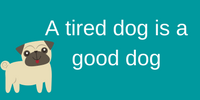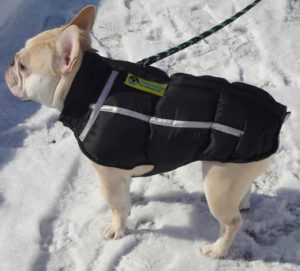With a long bout of sub-zero wind chills, long walks just can’t happen. With the holidays, our regular training class and home schedule have been shot to heck. And we’re all starting to get on each other’s nerves. When our dogs want our attention, they seem to know exactly which button to push to annoy us the most.
We’re making a point of practicing what we preach. 10 minutes of training is as exhausting to dogs as twice as much ‘fetch”. Exercising their minds is tiring. Remember how exhausted you were after final exams? Same kind of thing!
Creativity is key – make a game out of your sessions. It’s really fascinating and fun to see the dogs try to figure out what we’re asking them to do. You don’t need any elaborate equipment, just some great treats, some common household items, and a plan.
Get your plan in place first. Figure out what object you want to use, and what you want your dog to do with it.
Example: you’d like your dog to put her toys back in the toy box
Equipment needed: yummy treats (and lots of them!), a box or bin, your dog’s regular toys, and, (if your dog is clicker-trained) your clicker. (If you haven’t clicker-trained your dog, now is a great time to start! Check out the Clicker Training Kit – everything you need.)
Setup: With the dog out of the room, put the toys in a pile on one side of the room. Put the box or bin a few feet away.
Note: if you have more than one dog, only play with one at a time. The other dog(s) can watch, if you have crates available for them, or from the other side of a gate. Play-training needs your attention – the timing of your reward lets your dog know how good she is!
Start playing!
Let your dog in the room. You stand by the box or bin. Chances are he’ll go check the pile of toys: Click (or say yes!) and treat! Important – reward the same behavior (sniffing the pile) only about three times. If you don’t “up the ante,” your dog will think that’s the “end” behavior you want, instead of trying for something more.
Next step: wait for her to pick up one of the toys. (If your dog is already choosing and holding a toy, move on.) Watch for any progress beyond sniffing, like mouthing a toy, and reward. (Don’t reward pawing at the toys – she needs to use her mouth to pick up the toy.) Again, the 3x rule applies. Mouthing is good, but we’re looking for something more.
Note: You’re teaching your dog to think and make good decisions – to work with you figuring out what you want. Resist the temptation to “help” – just be quiet and let your dog try different things. If she doesn’t hear the “click” – she knows she needs to try something else.
After your dog is holding the toy, the next step is carrying it. At this point, just call your dog’s name, while he’s holding the toy. Reward a look toward you, a step would be wonderful – but only if he’s still got the toy. If he drops the toy when you call – just wait for him to pick it up and Reward!
Play-training sessions should be, at most, about 10 minutes long. Once you start seeing your dog catch on, you’ll probably want to keep going. It’s better to leave it be until the next time. If your dog isn’t catching on, don’t get frustrated. Just note where you left off and try again later. You may have to back up a step, but that’s okay! Everybody and every dog learn at their own pace. If your pup hasn’t done anything like this before, give her a chance to learn.
You may find that at your next play-training session (you can try two or three a day, if you have time), your dog will be brilliant – knowing everything you thought wasn’t getting through. Or your fast-learner will have forgotten everything from last time. There are ups and downs in training. Don’t worry about it. Give the forgetter a quick refresher and move on.
The next step is to get your dog to cross to the bin and you. If you have to take it step by step – that’s fine. If you have to run away from your dog to get him/her to move toward the bin, that’s fine. As long as you’re clear in your rewards, your dog will figure out what you want.
Part of being clear is ignoring the “stuff” you don’t want and just waiting patiently for the “stuff” you do want. Don’t say “no” or “uh oh” or any of that. Your reward is telling the dog she’s on the right track. No reward = not right.
When you’re got your dog carrying the toy by the bin, you can “cheat” a bit and put a yummy treat in the bin so your dog will “trade” the toy for the treat. If your dog knows “drop it,” you can certainly use the command, or start teaching it with the “trade.”
Note: If you’re not in a good mood or if you’re getting frustrated, stop the session. Your dog is probably tuned in to your emotions. He’ll just get frustrated, too, and you won’t accomplish much. Put it aside until the next time, when you’re feeling it more.
Quick checklist:
- Get your “plan” together in your mind – what are the steps toward your goal? What will you reward? Where did you leave off?
- Gather the “stuff” you need for your session
- Set up
- Set a timer for 10 minutes
- Get your dog
- Get play-training!
The basis for all play-training is having fun – for both of you. There are tons of other benefits; a better-behaved dog, a more confident dog, a closer relationship with your dog, and a tired dog. And we all know – a tired dog is a good dog!









